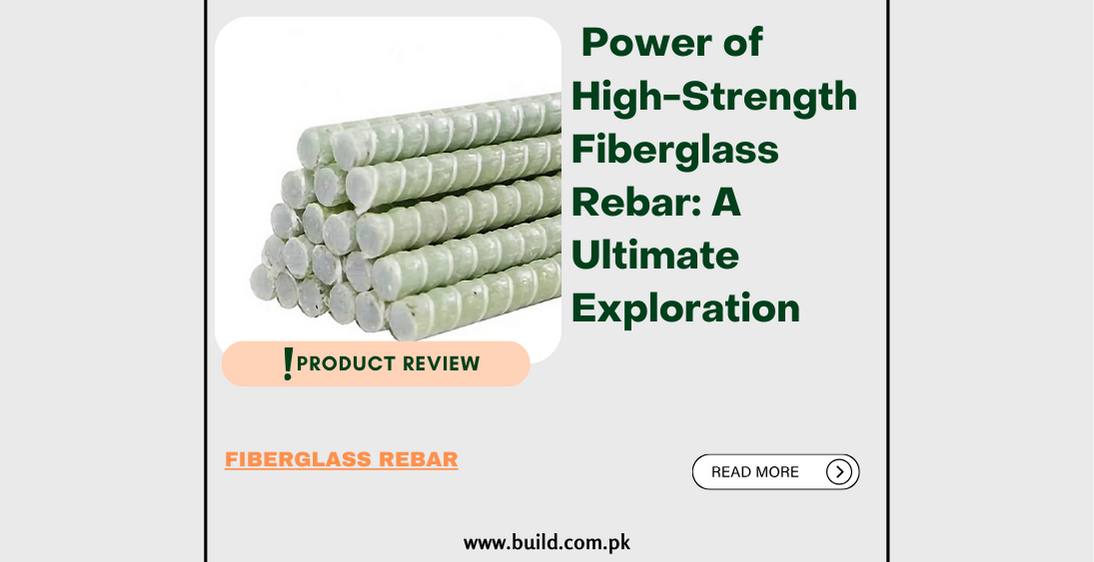Power of High-Strength Fiberglass Rebar: A Ultimate Exploration

Introduction:
In the world of construction and infrastructure, the choice
of reinforcement material plays a crucial role in ensuring the strength,
durability, and longevity of concrete structures. High-strength fiberglass
rebar has emerged as a revolutionary alternative to traditional steel
reinforcement, offering exceptional performance, corrosion resistance, and
sustainability. In this comprehensive exploration, we delve into the power of
high-strength fiberglass rebar, uncovering its unique characteristics, benefits,
applications, and the transformative impact it has on the construction
industry. Join us as we navigate through the world of fiberglass rebar,
discovering its immense potential and the endless possibilities it brings to
the realm of structural engineering and design.
Understanding High-Strength Fiberglass Rebar:
High-strength fiberglass rebar, also known as fiberglass
reinforced polymer (FRP) rebar, is a composite material made from high-strength
fiberglass strands embedded in a polymer matrix. This innovative reinforcement
material offers exceptional strength, durability, and corrosion resistance,
making it an ideal alternative to traditional steel rebar in concrete structures.
Characteristics of High-Strength Fiberglass Rebar
Strength and Durability:
High-strength fiberglass rebar boasts impressive tensile
strength, exceeding that of steel rebar, while also offering superior
resistance to corrosion, chemicals, and environmental factors. This combination
of strength and durability ensures long-lasting performance in various
structural applications, including bridges, buildings, highways, and marine
structures.
Corrosion Resistance:
Unlike steel rebar, which is susceptible to corrosion in
harsh environments, high-strength fiberglass rebar is inherently
corrosion-resistant. This resistance to rust and degradation ensures the
integrity and longevity of concrete structures, even in aggressive environments
such as coastal areas, chemical plants, and wastewater treatment facilities.
Lightweight and Easy to Handle:
High-strength fiberglass rebar is significantly lighter than
steel rebar, making it easier to handle, transport, and install on construction
sites. Its lightweight properties streamline construction processes, reduce
labor costs, and minimize the need for heavy lifting equipment, resulting in
faster project completion and increased efficiency.
Non-Conductive and Non-Magnetic:
Unlike steel rebar, which is conductive and magnetic,
high-strength fiberglass rebar is non-conductive and non-magnetic. This
inherent property makes it safe to use in electromagnetic environments, such as
MRI facilities, electrical substations, and communication towers, without interfering
with electronic equipment or posing safety hazards to personnel.
Thermal and Electrical Insulation:
High-strength fiberglass rebar offers thermal and electrical
insulation properties, making it suitable for applications where conductivity
or thermal bridging is a concern. This feature is particularly advantageous in
structures requiring insulation against temperature fluctuations or electrical
isolation, such as cold storage facilities, industrial plants, and data
centers.
Benefits of High-Strength Fiberglass Rebar
Longevity and Durability:
The exceptional durability and corrosion resistance of
high-strength fiberglass reb ar contribute to the longevity and reliability of
concrete structures, reducing the need for costly repairs and maintenance over
time. Its resistance to rust, chemical degradation, and environmental factors
ensures long-term performance and structural integrity, resulting in
significant cost savings for owners and operators.
Sustainability and Environmental Benefits:
High-strength fiberglass rebar is an eco-friendly alternative
to traditional steel rebar, offering significant sustainability benefits
throughout its lifecycle. Its production requires fewer natural resources and
emits fewer greenhouse gases compared to steel rebar, making it a more
environmentally friendly choice for sustainable construction practices.
Reduced Construction Time and Costs:
The lightweight and easy-to-handle nature of high-strength
fiberglass rebar streamline construction processes, resulting in reduced labor
costs, shorter construction schedules, and increased efficiency. Its corrosion
resistance eliminates the need for additional protective coatings or
treatments, further reducing material costs and project expenses.
Design Flexibility and Versatility:
High-strength fiberglass rebar offers design flexibility and
versatility, allowing architects and engineers to realize their creative vision
and design innovative structures with confidence. Its ability to be customized
to specific project requirements, including shape, size, and reinforcement
configuration, provides endless possibilities for architectural expression and
structural optimization.
Applications of High-Strength Fiberglass Rebar
Infrastructure Projects:
High-strength fiberglass rebar is widely used in infrastructure
projects, including bridges, highways, tunnels, and marine structures, where
durability, corrosion resistance, and long-term performance are critical. Its
lightweight properties and resistance to environmental factors make it an ideal
choice for enhancing the durability and longevity of concrete infrastructure in
challenging environments.
Building Construction:
In building construction, high-strength fiberglass rebar is
used in various applica tions, including foundations, slabs, walls, and columns,
where its strength, durability, and corrosion resistance contribute to the
structural integrity and longevity of concrete structures. Its lightweight
properties and ease of handling make it suitable for both residential and
commercial projects, reducing construction time and costs.
Infrastructure Rehabilitation:
High-strength fiberglass rebar is increasingly used in the
repair and rehabilitation of aging concrete structures, such as bridges,
parking garages, and wastewater treatment plants, where corrosion of
traditional steel reinforcement has compromised structural integrity. Its
corrosion resistance, compatibility with existing concrete, and ease of
installation make it an effective solution for extending the service life of
deteriorating infrastructure.
Conclusion:
In conclusion, high-strength fiberglass rebar represents a paradigm
shift in the field of construction and infrastructure, offering unparalleled
strength, durability, and sustainability compared to traditional steel
reinforcement. Its unique properties, including corrosion resistance,
lightweight design, and thermal insulation, make it an ideal choice for a wide
range of structural applications, from bridges and highways to buildings and
infrastructure rehabilitation projects. By harnessing the power of
high-strength fiberglass rebar, architects, engineers, and construction
professionals can create resilient, sustainable, and long-lasting concrete
structures that withstand the test of time and contribute to a more resilient
built environment for generations to come.









